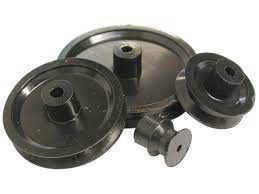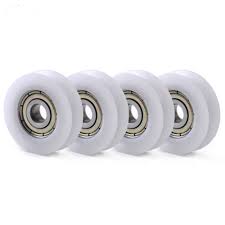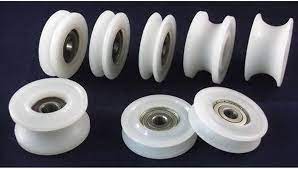Product Description
Small plastic ball bearing pulley wheel, nylon coated ball bearing for sliding door and windows Roller Pulley
1. Window and door pulley wheel roller with high quality low price.
2. High speed low noise with high precision.
3. Bearing manufacturer + trading.
4. Full sizes to choose.
5. Delivery in time.
6. OEM is available.
Product Catalog
Application: sliding door, sliding window
certification: ISO
Exhibition at Canton Fair
Excellent team building: QC team, QA team, management team, manufacture team, sales team
Cooperation factory and countries
Packaging
Transport & Payment
Customer evaluation is quite true.
FAQ
1.Can I get your some samples?Is it free or charged?
A: Yes,we can offer some pieces of samples, but the express cost is chanrged.
2.Could you accept OEM and customize?
A:Yes,we can customize for you according to sample or drawing.
3.How long is your delivery time?
A: Generally takes about 7-15 working days for production based on specifications for your order and quantity. In stock bearings can arrange shipment immediately once after payment received.
Is your company factory or Trade/Trading Company?/Are you trading company or manufacturer?
5.What about the delivery?
A: By express (DHL, UPS, FEDEX, TNT, EMS) to your door, By sea to your nearest port; By air to your nearest airport.
6.What’s the lead time?
A: 3-7 days for samples, 3-4 weeks for mass production.
7.Can you give warranty of your products?
A: Yes, we extend a 100% satisfaction guarantee on all items. Please feel free to feedback immediately if you are not pleased with our quality or service.
8.What’s your payment terms?
A: Payment/Amount lower than =1000USD 30%T/T in advance,balance before shipment.
9.Dose your factory have any certificate?
A: Yes.we have ISO 9001:2008,IQNET and SGS. If you want other like CE,we can do for you.
10.Do you have stock for all item?
A: Yes, we have sufficient stock and can do fast delivery.
If you have any problems, please be free to contact me.
/* January 22, 2571 19:08:37 */!function(){function s(e,r){var a,o={};try{e&&e.split(“,”).forEach(function(e,t){e&&(a=e.match(/(.*?):(.*)$/))&&1
| Contact Angle: | 0 |
|---|---|
| Aligning: | Non-Aligning Bearing |
| Separated: | Separated |
| Samples: |
US$ 0.1/Piece
1 Piece(Min.Order) | Order Sample guaranteed quality
|
|---|
| Customization: |
Available
| Customized Request |
|---|
.shipping-cost-tm .tm-status-off{background: none;padding:0;color: #1470cc}
|
Shipping Cost:
Estimated freight per unit. |
about shipping cost and estimated delivery time. |
|---|
| Payment Method: |
|
|---|---|
|
Initial Payment Full Payment |
| Currency: | US$ |
|---|
| Return&refunds: | You can apply for a refund up to 30 days after receipt of the products. |
|---|
How do plastic pulleys impact the performance of garage door systems?
Plastic pulleys have a significant impact on the performance of garage door systems. Here’s a detailed explanation:
1. Smooth and Quiet Operation:
Plastic pulleys are designed to provide smooth and quiet operation in garage door systems. The use of plastic materials, such as high-density polymer or nylon, in the pulleys reduces friction and minimizes noise during the opening and closing of the garage door. The smooth movement facilitated by plastic pulleys enhances the overall user experience and ensures a quieter operation, especially compared to metal pulleys that can create more noise and require more lubrication.
2. Durability and Longevity:
Plastic pulleys offer excellent durability and longevity in garage door systems. The plastic materials used in the construction of these pulleys are resistant to corrosion, rust, and moisture, making them suitable for outdoor applications. Plastic pulleys are less susceptible to wear and tear, which extends their lifespan and reduces the frequency of replacements. Their durability ensures consistent performance and reliable operation of the garage door system over an extended period.
3. Reduced Maintenance:
Due to their durable nature and self-lubricating properties, plastic pulleys require less maintenance compared to metal pulleys. The plastic materials used in the pulleys do not require frequent lubrication, unlike metal pulleys that may require regular oiling or greasing. This reduces the maintenance efforts and costs associated with keeping the garage door system in optimal condition. Additionally, plastic pulleys are less prone to accumulation of dirt or debris, further minimizing the need for cleaning or debris removal.
4. Improved Safety:
Plastic pulleys contribute to improved safety in garage door systems. The use of plastic materials reduces the risk of injury or damage in case of accidental contact with the pulleys while the door is in motion. Unlike metal pulleys, plastic pulleys have a smooth and lightweight construction, reducing the potential for accidents or injuries. Additionally, the reduced friction and smoother movement provided by plastic pulleys decrease the strain on the garage door opener and other components, enhancing the overall safety and reliability of the system.
5. Cost-Effectiveness:
Plastic pulleys offer a cost-effective solution for garage door systems. They are generally less expensive than metal pulleys, making them a budget-friendly option for homeowners and businesses. Moreover, the durability and longevity of plastic pulleys result in reduced maintenance and replacement costs over time. The cost-effectiveness of plastic pulleys makes them a popular choice in residential and commercial garage door systems.
6. Compatibility:
Plastic pulleys are designed to be compatible with various garage door systems. They are available in different sizes and configurations to match the specific requirements of different door types and mechanisms. Plastic pulleys can be easily installed or replaced in existing garage door systems, providing a hassle-free solution for homeowners and professionals.
7. Energy Efficiency:
Plastic pulleys contribute to energy efficiency in garage door systems. The smooth and low-friction operation of plastic pulleys reduces the amount of energy required to open and close the garage door. This energy efficiency can result in lower electricity consumption and reduced costs over time, especially in cases where the garage door is frequently used.
Overall, plastic pulleys have a positive impact on the performance of garage door systems. They provide smooth and quiet operation, durability, reduced maintenance, improved safety, cost-effectiveness, compatibility, and energy efficiency. These benefits make plastic pulleys a preferred choice for homeowners and professionals seeking reliable and efficient garage door operation.
What role do plastic pulleys play in automotive engines and accessory systems?
Plastic pulleys play an essential role in automotive engines and accessory systems. Here’s a detailed explanation of the role of plastic pulleys in these applications:
1. Belt Driven Systems:
In automotive engines, plastic pulleys are commonly used in belt-driven systems. These systems include components such as the alternator, power steering pump, air conditioning compressor, water pump, and various accessory drives. Plastic pulleys are used as the guiding and tensioning components for the belts that drive these systems. They help maintain proper belt tension, ensure smooth operation, and facilitate the transfer of power from the engine to the various accessory components.
2. Lightweight Design:
Plastic pulleys offer the advantage of being lightweight compared to their metal counterparts. This lightweight design contributes to overall weight reduction in the vehicle, which is crucial for improving fuel efficiency and reducing emissions. By using plastic pulleys in automotive engines and accessory systems, manufacturers can achieve weight savings without compromising the strength and durability required for reliable operation.
3. Low Friction and Efficiency:
Plastic pulleys are designed to have low friction surfaces. This characteristic reduces the resistance encountered by the belts during operation, resulting in improved efficiency. The reduced friction helps optimize the power transfer from the engine to the accessory systems, ensuring that energy is not wasted and maximizing the overall efficiency of the vehicle. The use of plastic pulleys helps minimize energy losses and contributes to the performance and fuel economy of the automotive engine.
4. Corrosion Resistance:
Automotive engines and accessory systems are exposed to various environmental conditions, including moisture, heat, and chemicals. Plastic pulleys offer excellent resistance to corrosion, which is particularly beneficial in these demanding environments. Unlike metal pulleys that may rust or corrode, plastic pulleys remain unaffected by moisture or chemicals. This corrosion resistance ensures long-lasting performance and reduces the need for frequent replacements, contributing to the reliability and longevity of automotive engines and accessory systems.
5. Noise and Vibration Damping:
Plastic pulleys have inherent damping properties that help reduce noise and vibration in automotive engines and accessory systems. The damping effect of plastic materials absorbs vibrations generated during belt operation, resulting in smoother and quieter system performance. This is important for improving the overall driving experience and reducing the noise levels inside the vehicle cabin. Plastic pulleys help minimize noise and vibration, contributing to user comfort and the overall quality of the vehicle.
6. Design Flexibility:
Plastic pulleys offer a high degree of design flexibility, allowing for precise customization to match the specific requirements of automotive engines and accessory systems. They can be molded into various shapes, sizes, and configurations, enabling efficient integration into different engine layouts and space constraints. Plastic pulleys can incorporate features such as grooves, flanges, or mounting options directly into the design, ensuring optimal belt engagement and alignment. This design flexibility helps optimize the performance and reliability of automotive engines and accessory systems.
7. Cost-Effectiveness:
Plastic pulleys are generally cost-effective compared to their metal counterparts. The manufacturing process for plastic pulleys is typically less complex and less expensive, resulting in lower production costs. This cost advantage makes plastic pulleys a preferred choice in automotive applications where multiple pulleys are required, such as in serpentine belt systems. Plastic pulleys offer a balance between performance, durability, and affordability, contributing to the cost-effectiveness of automotive engines and accessory systems.
In summary, plastic pulleys play a vital role in automotive engines and accessory systems by guiding and tensioning belts, providing lightweight design, reducing friction and improving efficiency, offering corrosion resistance, damping noise and vibration, providing design flexibility, and delivering cost-effectiveness. Their contributions to these systems result in better performance, fuel efficiency, reliability, and overall driving experience in vehicles.
What is a plastic pulley, and how does it compare to other types of pulleys?
A plastic pulley is a type of pulley made primarily from plastic materials, such as nylon, polyethylene, or polycarbonate. It is designed to perform similar functions as other types of pulleys but offers distinct advantages and considerations. Here’s a detailed comparison of plastic pulleys with other types of pulleys:
1. Material:
Plastic pulleys are specifically engineered to be lightweight and durable. They are resistant to corrosion, moisture, and many chemicals, making them suitable for various environments. In contrast, other types of pulleys, such as metal pulleys, may be heavier and prone to rust or corrosion without proper protection.
2. Cost:
Plastic pulleys tend to be more cost-effective compared to metal pulleys or pulleys made from other materials like ceramic or glass. The manufacturing process for plastic pulleys is generally less expensive, resulting in lower production costs and, consequently, lower prices for consumers.
3. Noise and Vibration:
Plastic pulleys often provide quieter operation compared to metal pulleys. The inherent damping properties of plastic materials help reduce noise and vibration during pulley rotation. This makes plastic pulleys suitable for applications where noise reduction is desired, such as in household appliances or office equipment.
4. Friction and Wear:
Plastic pulleys generally have lower friction coefficients compared to metal pulleys. This can result in reduced wear and tear on the pulley itself and the associated components, such as belts or ropes. However, it’s important to note that the selection of the appropriate plastic material and design considerations are crucial to ensure sufficient strength and wear resistance for the intended application.
5. Load-Bearing Capacity:
While plastic pulleys can handle moderate loads, they may have lower load-bearing capacities compared to metal pulleys. Metal pulleys, especially those made from robust materials like steel or cast iron, are typically stronger and capable of withstanding higher loads. Therefore, in heavy-duty applications or situations where significant forces are involved, metal pulleys may be preferred.
6. Temperature Resistance:
Plastic pulleys have varying temperature resistance depending on the specific material used. Some plastics can withstand a wide temperature range, while others may have limitations. For example, nylon can handle higher temperatures compared to polyethylene. In contrast, metal pulleys generally have higher temperature resistance, making them suitable for high-temperature environments.
7. Application Specificity:
The choice between plastic pulleys and other types of pulleys often depends on the specific application requirements. Plastic pulleys are commonly used in light to moderate load applications, such as in small appliances, office equipment, or recreational devices. Metal pulleys, on the other hand, are often preferred in heavy-duty applications, industrial machinery, or situations where high strength and durability are paramount.
8. Customization:
Plastic pulleys offer flexibility in terms of design and customization options. They can be easily molded into various shapes and sizes, allowing for specific features or geometries to be incorporated. This makes plastic pulleys suitable for applications where precise customization is required. Metal pulleys may require more extensive machining or manufacturing processes for customization.
In conclusion, plastic pulleys offer unique advantages such as lightweight construction, corrosion resistance, cost-effectiveness, noise reduction, and design flexibility. However, they may have limitations in terms of load-bearing capacity and temperature resistance compared to metal pulleys. The choice between plastic pulleys and other types of pulleys depends on factors such as application requirements, load conditions, environmental considerations, and budget constraints.
editor by CX
2024-04-10




